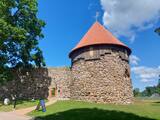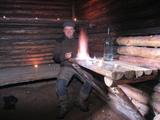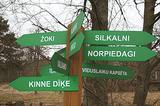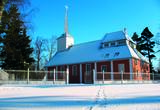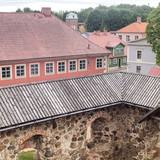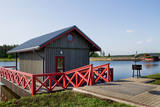| Nr | Nosaukums | Apraksts |
|---|---|---|
|
1342.gadā lielākajā no Alūksnes ezera salām – Pilssalā – Livonijas ordenis pabeidza mūra pils celtniecību. Pili iesvētīja Marijas pasludināšanas dienā, tāpēc šī vieta ieguva sev jaunu nosaukumu Marienburga. Alūksnieši joprojām piemin Alūksnes meiteni Mariju, kura it kā iemūrēta vienā no pils sienām, tāpēc salu dēvē gan par Pilssalu, gan Marijas salu. Gadsimtu laikā mainījās pils valdnieki, tā piederēja gan krieviem, gan zviedriem, gan poļiem. Ir atjaunots Livonijas ordeņa pils priekšpils Dienvidu tornis– vienīgais no senās viduslaiku pils astoņiem torņiem, kas būtiskā vēsturiskā apjomā ir saglabājies līdz mūsdienām. Šobrīd Dienvidu tornī apskatāma mūzikas un gaismas ekspozīcija "MARIENBURGAS astotais brālis”, kas ir iztēli rosinošs un emocijām piesātināts piedzīvojums. Ekspozīcijas tapšanas procesā apvienojušies vairāki izcili mākslinieki: dramaturgs Lauris Gundars, komponisti Mārtiņš Brauns un Artūrs Maskats, skaņas dizaineris Sigvards Kļava un dizaina birojs H2E. Teiksmu ar Ojāra Vācieša vārdiem iedzied Latvijas Radio koris. Pieejamība: Dabas objekts ir pieejams cilvēkiem ar pārvietošanās grūtībām. |
||
|
Maršruts piemērots laivotājiem, kam nepatīk vienveidība. Latgales ezeri joprojām ir ūdenstūristu mazapgūta teritorija, taču ļoti pievilcīga gan ainavu, gan kultūrvides ziņā. Maršruta informācija no Latvijas Lauku foruma |
||
|
Atrodas Alekšupītes labajā krastā pirms tās ietekas Ventā. Saglabājušās ziņas, ka pirmās dzirnavas šajā vietā tika celtas līdz ar Kuldīgas pils būvniecību 13. gs. Hercoga Jēkaba laikā dzirnavās taisīja šaujamo pulveri. Vēlāk šī bija pirmā vieta Kurzemē, kur ražoja papīru. Tagad redzamo veidolu ēka ieguva 19. gs. Padomju laikā dzirnavās ierīkoja metālapstrādes darbnīcu. Šobrīd vēsturiskā dzirnavu ēka tiek atjaunota. Apskatāma no ārpuses. |
||
|
Mežabrāļu lauku māja atrodas pie Igaunijas un Latvijas robežas. Staigājot pa mežabrāļu takām var apmeklēt viņu raktos bunkurus, klausīties patiesus stāstus par pēckara notikumiem, nogaršot kandžu “meža šalkas” un kopā ar saimnieku uzdziedāt mežabrāļu dziesmas. Piedzīvojumu mīļotājiem piedāvājam arī naktsmītnes mežabrāļu bunkurā. Ziemā Mežabrāļu saimes ļaudis aicina braukt ar ragaviņām no Punkrimeģa un pavizināties kamanās. |
||
|
Meklējams netālu no A9 autoceļa, uz rietumiem no Bataru mājām, kur 1919. g. 22. martā norisinājās cīņa starp ģenerāļa Jāņa Baloža brigādi un lieliniekiem. Atklāts 1936. gadā. |
||
|
Košragu uzskata par jaunāko lībiešu jūrmalas ciemu (veidojies 17. gs.). 1826. g. Košragā bija 78 iedzīvotāji. 1832. g. Žokos atvēra Dundagas jūrmalas ciemos pirmo lasītmācīšanas skolu lībiešu bērniem, kur par skolotāju strādāja pirmais profesionālo izglītību ieguvušais lībietis Nika Polmanis, kurš austrumu izloksnē iztulkoja Mateja evaņģēliju. Košragā bija vējdzirnavas, ūdensdzirnavas, laivu būves vieta. Pavasaros te piestāja laivas ar darba meklētājiem no Sāmsalas. 1932. g. izbūvēja ostu, 1938. g. - molu mudas (jūras mēslu) vākšanai. Pagājušā gs. 30. gados Košragu regulāri apmeklēja somu un igauņu valodnieki, kuri te savāca visvairāk lībiešu folkloras vienību. Norpiedagu mājas cēla lībiešu sabiedriskais darbinieks - Didriķis Volganskis (1884 - 1968). Tur piedzima viņa dēls - lībiešu kultūras darbinieks, mācītājs (Somijā) Edgars Vālgamā (Volganskis, 1912 - 2003), kurš lībiski pārtulkoja A. Pumpura eposu „Lāčplēsis” somu valodā. Mūsdienās Košrags ir valsts nozīmes kultūras piemineklis. |
||
|
Arbūzu audzēšanu saimnieki uzsāka 1997. g., izmantojot šķirnes, kas piemērotas Latvijas klimatiskajiem apstākļiem. Saimniecības „odziņa” ir arbūzi ar dzelteno mīkstumu. Lielākais izaudzētais arbūzs svēris 11 kg. Sezonas laikā – arbūzu iegāde un saimnieka padomi. |
||
|
Ar niedrēm aizaudzis, piejūras pļavu, lagūnu, dūņainu ezeriņu un smilšainu sēkļu mozaīkas izraibināts Rīgas līča krasta posms starp Ainažiem un Kuivižiem – Randu pļavas – putniem un augiem nozīmīga vieta. Aizsargājams biotops un dabas liegums. Pļavu iepazīšanai izveidots putnu vērošanas tornis un dabas taka. Atrodas Ziemeļvidzemes biosfēras rezervātā.
|
||
|
Atrodas Daugavas prospektā 10, starp Rīgas – Daugavpils šoseju (A 6) un Kalēju ielu. Dievnams celts laikā no 1931. - 1933. g. (arhitekts: Pēteris Kundziņš). Padomju gados tajā bija izvietota Latvijas Valsts bibliotēkas grāmatu glabātava. Pateicoties draudzes aktivitātēm 1989. g., ēku atjaunoja. Tagad tā kalpo savam pamatmērķim. |
||
|
Romas katoļu Dieva Žēlastības baznīca 1998. gada 19. aprīlī – t.s. “Baltajā svētdienā” jeb Dieva Žēlastības dienā – tika iesvētīta Saulkrastu Romas katoļu Dieva Žēlastības baznīca. Celtnes garums – 24 m, torņa augstums – 16 m. Baznīcu projektējis arhitekts Jānis Šrēders. Dievnamā ir 300 vietu. Kristus tēls altārgleznā ir tāds, kādu to vīzijā 1931. gada 22. februārī Polijas klosterī redzējusi svētā klostera māsa Faustīna, un to veidojis mākslinieks Ēriks Pudzēns.14 gleznās pie baznīcas sienām attēlots ciešanu ceļš – Kristus krusta ceļš no notiesāšanas līdz augšāmcelšanās brīdim. Altāris būvēts no cēlkoka oša. 1998. gada 2. augustā pie Saulkrastu Romas katoļu Dieva žēlastības baznīcas tika iesvētīts 7,38 augsts krusts. Naktī šis krusts tiek izgaismots. Tas ir līdzinieks Golgātas krustam Jeruzalemē, pie kura bija piesists Jēzus Kristus. (Avots: Saulkrastu TIC) |
||
|
Atrodas bijušās Lašu mācītājmuižas ēkā - 0,5 km ziemeļaustrumos no Neretas – Ilūkstes ceļa. Gothards Frīdrihs Stenders (1714. – 1796.) jeb Vecais Stenders bija pirmās plašākās latviešu valodas gramatikas (1761. g.), latviešu-vācu un vācu-latviešu vārdnīcas (1789. g.), latviešu ābeces (1782. g.) un pirmās ilustrētās ābeces “Bildu ābice” (1787. g.) autors, strādājis par Sēlpils un Sunākstes mācītāju. Viņa dzimšanas vieta bija Lašu mācītājmuiža, kuras vienā no ēkām ir izveidots neliels muzejs. Neretas – Ilūkstes ceļa malā ir uzstādīts piemiņas akmens (tēlnieks I. Folkmanis, arhitekte N. Tamane). |
||
|
Saimniece piedāvā sertificēta pirtnieka pakalpojums, organizē latviskos pirts rituālus, vada izglītojošas programmas par augu spēku izmantošanu savai labsajūtai. Apvienojot pirtnieka pakalpojumus un pašas ražoto produkciju, saimniece radījusi zīmolu - “Arnitas labsajūtu darbnīca”. Kā mājražotāja piedāvā pašceptu maizi, zāļu tējas un augu sīrupus, kā arī meistardarbnīcas kulinārā mantojuma jomā. |
||
|
Uzskata, ka Limbažu Ķezberkalniņā bijusi Metsepoles lībiešu novada pils Lemisele. Tāpat atrodamas ziņas, ka līdz pat 16. gs. no jūras pa Svētupi un Dūņezeru līdz šejienei braukuši tirgoņi. 1223. g. bīskaps Alberts Limbažos uzbūvēja mūra pili. Limbaži tāpat kā Valmiera kļuva par Hanzas savienības locekli. 16. gs. sākumā gan tās ekonomiskā loma ievērojami samazinājās, jo Svētupe un Dūņezers kļuva kuģniecībai neizmantojami. Laikā no 16. – 18. gs. pilsēta un pilsētnieki cieta no kariem, slimībām un ugunsgrēkiem. Tā rezultātā iedzīvotāju skaits sasniedza savu visliekāko kritumu – astoņi cilvēki. 19. – 20. gs. mijā un 20. gs. sākumā saimnieciskā dzīve atkal atjaunojas. |
||
|
Masīvā baznīca celta 1780. - 1781. g. barona H. F. Bēra laikā, bet pārbūvēta 1876. un 1888. g. Dievnams ir pazīstams ar savu izsmalcināto rokoko stila altāri un kanceli un 18. gs. 1. pusē darinātajām ērģelēm. Tajā atrodas arī citi nozīmīgi mākslas pieminekļi. Baznīcas kapenēs bija novietotas Aizputes muižas dzimtkundzes J. E. fon Bilovas un viņas meitas J. E. fon Bēras sarkofāgi, kas pārvietoti uz Rundāles pils muzeju. Baznīca apskatāma arī no iekšpuses. |
||
|
Zemnieku saimniecība Nurka atrodas Luitemaa dabas aizsardzības apgabalā Pērnavas apriņķī. Saimniecības komplekss, kas ir vecāks par 100 gadiem, ir atjaunots par mūsdienīgu brīvdienu māju ar visām mūsdienu ērtībām. |
||
|
The tour takes through all three Baltic States – Lithuania, Latvia and Estonia. The route visits the capital cities and some of the most attractive cities and towns in Mid - Baltics. The tour starts in Vilnius, the capital city of Lithuania. Kaunas is the second largest Lithuanian city, standing at the confluence of the Nemunas and Neris Rivers. Riga, the capital city of Latvia, offers a variety of cultural experiences and entertainment. Sigulda is famous for its landscapes and medieval castles. Cēsis is one of the most charming towns in Latvia with many attractions ranging from medieval heritage to nice restaurants, exhibitions and festivals. Valmiera offers art galleries, museums, nature trails and Valmiermuža beer from the famous local brewery. Tartu in Estonia is a university town, with some very popular tourist attractions such as the interactive AHHAA science centre, the largest in Baltic countries. Finish the tour in Tallinn – the capital city of Estonia. Tourist information centres in cities and towns will help you with maps, information on sights, attractions and guided tours, food, shopping and public transport. |
||
|
Krodziņš "Rūdolfs" atrodas Kokneses centrā, Kokneses muižas pārvaldnieka mājā, un nosaukts latviešu novelista Rūdolfa Blaumaņa vārdā, kas mācījies muižā un nodzīvojis tajā divus gadus. Latviešu virtuve: Rasols, siļķu salāti, pupiņu salāti, Valmieras salāti, sīpolu sitenis, cūkgaļas ribiņas, mājas kotletes, cepetis mārrutku mērcē, cepta akna, siļķe ar biezpienu, auzu pārslu kārtojums. Īpašais ūdens: „Krodzinieka šķēle”. |
||
|
Krustceļu vecticībnieku draudzes dievnams celts 1939. gadā
|
||
|
Atpūtas kompleksā ir iespējams gan makšķerēt karpu dīķī, gan peldēties un sauļoties labiekārtotā pludmalē uz zviļņiem. Bērniem ir izveidots rotaļu laukums. Iespējams rīkot arī banketus, seminārus un citus pasākumus. Tāpat pieejama pirts ar kamīnzāli atpūtai līdz 20 cilvēkiem. Nakšņošanai tiek piedāvāti četri kempingi, kas izvietoti virs ūdens uz pāļiem. Visi namiņi ir apsildāmi, ar atsevišķu dušu un tualeti, TV un wi-fi internetu. Divos no tiem ir pieejama virtuve, bet vienā - arī kamīns. Katrā namiņā ir trīs vai četras gultasvietas. Tāpat pieejamas telts un kemperu vietas, iespējams uz vietas arī iznomāt teltis.
|
||
|
Гостевой дом находится в 300-летнем здании пивоварни Омульского фольварка, расположенного в 20 км от Валки. Хозяйство занимается производством домашних копченостей, сыров, белого хлеба, кисло-сладкого и ржаного хлеба. Подворье со скотом, баня. |
||
